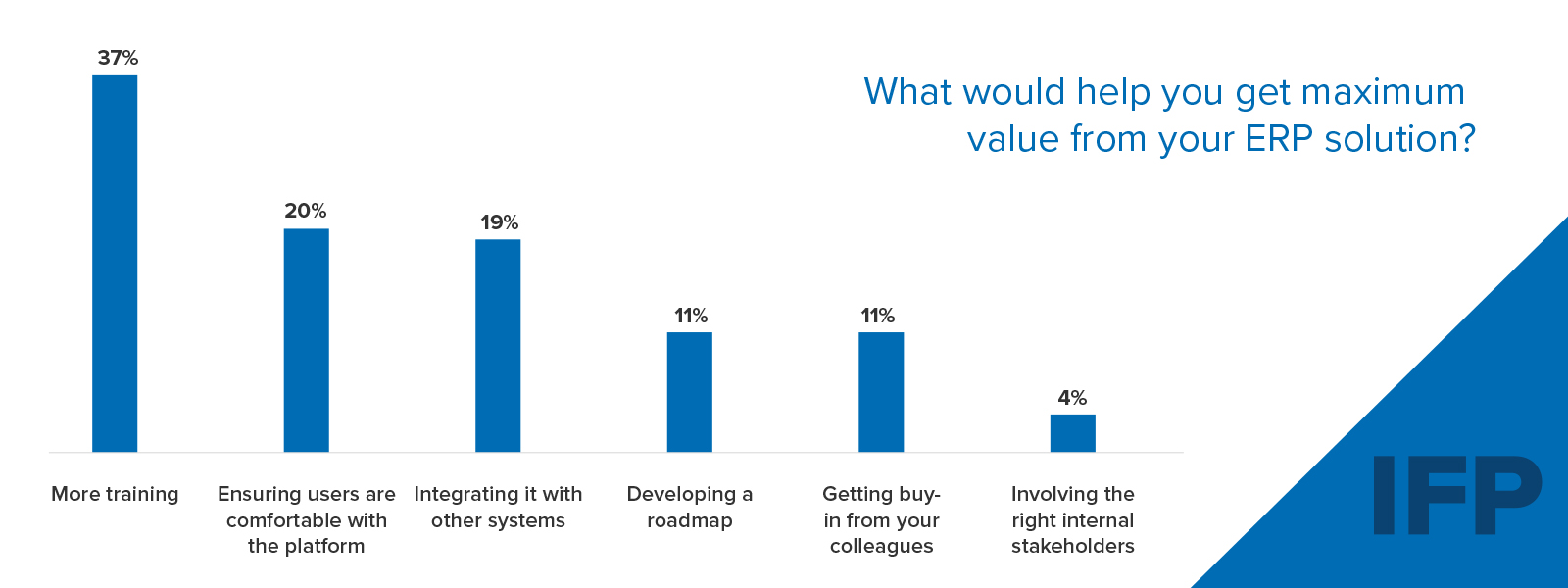The enterprise resource planning (ERP) market is on the rise. In 2021, it was valued at $50.45 billion and is expected to reach $117 billion by the end of the decade – a compound annual growth rate (CAGR) of 9.88%.
There are various reasons why these solutions are proving so popular. According to an IFP survey of over 200 finance leaders, some of the biggest benefits they’ve experienced when adopting ERP platforms include standardizing processes and boosting efficiency (61%), improved productivity and collaboration (57%) and better reporting (54%).
And, looking into how ERP has impacted and transformed business operations, 67% cite increased visibility into data and 50% point to process optimization and acceleration of digital transformation initiatives. On top of this, integration with other systems (48%) and elimination of departmental silos (20%) are two other significant benefits.
For modern enterprises and businesses, the benefits of ERP are clear, and adopting these platforms is crucial to thriving in data and transformation-driven markets and business landscapes.
However, onboarding ERP is far from a smooth process, and the task of getting maximum value from these solutions doesn’t end once it’s implemented.
So what can finance leaders do to ensure their teams – from end users all the way up to strategic decision-makers across departments – get the most out of these platforms?
6 ways to get maximum value from your ERP solution
1. More training
37% of our respondents cite providing more training as the best way to get more value from their ERP platform. A comprehensive understanding of the software's capabilities and functionalities allows teams to streamline processes, enhance decision-making, optimize resource allocation and ultimately use the system to its full potential. In addition, well-trained staff can identify opportunities for improvement and harness the insights generated by the ERP system to drive growth and competitiveness.
2. Ensure users are comfortable with the platform
The second most popular best practice identified by respondents is ensuring users are comfortable with the ERP platform (20%). An intuitive and user-friendly interface not only facilitates seamless adoption but also enhances the overall efficiency of the system. A comfortable user experience fosters increased productivity, as employees can proficiently navigate through the platform, minimizing the learning curve and reducing the possibility of errors. Consequently, this leads to accurate data input, better decision-making and improved resource management.
3. Integration with other systems
Already outlined as a core transformational benefit of ERP, further integration with other systems (19%) is another key way finance leaders can get the most out of their solution. This is because it allows for seamless data exchange and streamlined processes across various departments and software applications. Connecting disparate systems can help you:
- Enhance operational efficiency
- Promote collaboration among teams
- Eliminate data silos
- Reduce the likelihood of data redundancy
- Drive improved decision-making
4. Developing a roadmap
Developing a roadmap is an essential step for businesses seeking to unlock the full potential of their ERP solution, and was selected by 11% of respondents.
A well-crafted roadmap serves as a strategic blueprint, outlining the implementation process, milestones and desired outcomes. Setting clear objectives and timelines can help businesses effectively allocate resources and manage expectations throughout the ERP journey.
5. Getting buy-in from colleagues
Obtaining buy-in from colleagues is a critical aspect in ensuring businesses extract maximum value from their ERP solution, as identified by 11% of respondents. This is primarily because ERP systems are designed to integrate various departments and streamline their processes, leading to efficient business operations. The success of an ERP implementation largely depends on the collective effort of all stakeholders involved, including colleagues from different departments who utilize the system daily. When colleagues understand the potential benefits and core objectives of the ERP solution, they are more likely to actively participate in the implementation process, provide valuable insights and embrace the new system.
6. Involving the right internal stakeholders
Similarly, getting the right internal stakeholders (3%) who possess the necessary expertise, knowledge and understanding of the organization's processes, challenges and goals is crucial to getting the most from your ERP. By involving them in ERP from planning to implementation and strategy, businesses can accurately identify the specific needs and requirements of their organization, aligning the ERP system with their strategic objectives.
Having the right stakeholders onboard also facilitates smooth communication and collaboration among various departments.
Access the State of Enterprise Resource Planning research report
For more detailed insights into ERP implementation best practices, including statistics on the biggest challenges and investment priorities going forward, download the full report here.
Access the latest business knowledge in Finance
Get Access



Comments
Join the conversation...